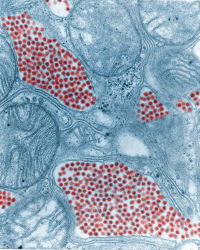Togaviridae
A Viral Biorealm page on the family Togaviridae
Baltimore Classification
Higher order taxa
Viruses; ssRNA positive-strand viruses, no DNA stage; Togaviridae
Genera
Alphavirus, Rubivirus
Description and Significance
Togaviruses are divided into two genera: Rubivirus and Alphavirus. The genus Rubivirus contains only one species, Rubella virus, which is one of the five most common childhood illnesses (along with measles, chicken pox, roseola, and fifth disease). The genus Alphavirus contains 26 members, each member consisting of numerous strains. The members of the Alphavirus genus are arboviruses, or arthropod-born viruses, meaning arthropods are the transmission vector. (sources: CDC, Strauss and Strauss)
Genome Structure
The togavirus genome is non-segmented and contains a molecule of linear, positive-sense, single-stranded RNA. The complete genome is 9700-11800 nucleotides long. The 5'-terminus has a methylated nucleotide cap. (source: ICTVdB)
Virion Structure of a Togavirus
Togavirus virions consist of an envelope and a nucleocapsid. The virions are spheical to pleomorphic in shape, and about 70 nm in diameter. Glycoprotein spikes evenly cover the surface of the virion. The genome is contained in the T=4 icosahedral capsid, which measures 40 nm in diameter. (sources: Garoff, ICTVdB)
Reproduction Cycle of a Togavirus in a Host Cell
Togaviruses attach to the surface of a cell using the glycoprotein spikes that cover the virion surface, and are absorbed into the cell. According to Novoa et al., the togavirus creates "factories" for virus reproduction around the host cell's endosomes and lysosomes, sites for viral replication unique to togaviruses. The replication complexes of the togaviruses are not derived from the endosomes or lysosomes, however. Instead, it appears that the complexes are derived from the endoplasmic reticulum.
RNA transcription is similar to that of other positive-sense RNA viruses. The positive-sense RNA functions as the mRNA and is used to create a negative-sense RNA template. The negative-sense RNA template is used to create new positive-sense RNA genomes, which are packaged into nucleocapsids. Rubellavirus virions are assembled and mature in the Golgi complex, while alphavirus virions are present in the cytoplasm before budding and mature almost simultaneously with budding. The virions bud from the host cell, gaining their envelopes as they exit.
Viral Ecology & Pathology
The ecology and pathology of togaviruses vary greatly between the two genera. Rubella, the only species in Rubivirus, is very similar to measles. Humans are the only reservoir for the virus, and transmission is airborne. Infections produce a maculopapular rash similar to the measles rash, but the rubella rash is fainter and does not coalesce. Infections in pregnant women can infect the fetus as well, resulting in Congenital Rubella Syndrome (CRS). CRS can cause birth defects, mental abnormalities, deafness, cataracts and other eye defects, and even death in infants. Prevention of CRS is one of the main objectives or rubella vaccination programs in the United States.
In contrast, alphaviruses are arboviruses, meaning the transmission vector is arthropods. Other arboviruses are in the families Flaviviridae and Bunyaviridae. Alphaviruses cause encephalitis. Like other arboviruses which cause encephalitis, the reservoir for alphaviruses is a nonhuman vertebrate host. For example, the primary reservoir for the alphavirus Eastern Equine Encephalitis (EEE) is birds (despite the name of the virus, horses are not a reservoir and, according to the CDC, are considered "dead end hosts" for the virus. Horses can, however, become ill due to EEE). (source: CDC)
References
Centers for Disease Control and Prevention. Epidemiology and Prevention of Vaccine-Preventable Diseases. Atkinson W, Hamborsky J, McIntyre L, Wolfe S, eds. 9th ed. Washington DC: Public Health Foundation, 2006.
Garoff, Henrik, Mathilda Sjöberg and R. Holland Cheng. "Budding of Alphaviruses." Virus Research 106.2 (2004): 103-116.
ICTVdB - The Universal Virus Database, version 4. http://www.ncbi.nlm.nih.gov/ICTVdb/ICTVdB/

